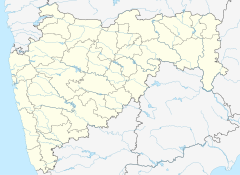Menawali
| Menawali | |
|---|---|
| Name | |
| Other names | Moteshwar Mahadev |
| Proper name | Menawali Shiv Mandir |
| Devanagari | मेणवली |
| Geography | |
| Coordinates | 17°58′06″N 73°51′44″E / 17.9683441°N 73.8623607°ECoordinates: 17°58′06″N 73°51′44″E / 17.9683441°N 73.8623607°E |
| Country | India |
| State/province | Maharashtra |
| District | Satara |
| Locale | Menawali |
| Culture | |
| Primary deity | Shankar (Shiva) |
| Important festivals | Mahashivratri |
| Architecture | |
| Architectural styles | Nagara |
| Number of temples | 3 |
| History and governance | |
| Date built | 1739 |
Menawali (मेणवली) is a village about three kilometres from Wai in the Satara district.The village is well connected by Road.Nana Fadnavis, 18th century Maratha statesman and the regent of Peshwa Madhavrao II built a residence here.
Chimaji Appa, Maratha general and brother of Bajirao I collected five large bells from Vasai Fort after he captured the fort from the Portuguese in 1739.He offered the bells at Bhimashankar , at Menavali near Wai in front of a Shiva Temple on the banks of the Krishna river, Banshanker temple( Pune), Omkareshwar Temple( Pune) and Ramlinga temple Shirur.Later in the 18th century,Nana Fadnavis built a large residence here.
The Nana Phadnavis Wada is a large six-quadrangular, perimeter-protected wada.
Bhavan Rao Trymbak Pant Pratinidhi of Aundh and Raghunath Ghanshyam Mantri (Satara) bestowed the village of Menavali to Nana Phadnavis in December 1768.
Nana Phadnavis settled the village and built a Wada (A mansion with an inner courtyard), a Ghat (steps) leading from the mansion to the Krishna river and the two temples, one dedicated to Lord Vishnu and another to Meneshwar (मेणेश्वर) Lord Shiva. The architectural combination of a Wada-type residence, a Ghat on a water-body and a Temple was typical of Peshwa era.This construction was completed around 1780. The Phadnavis wada is one of the very rare places where such a combination is preserved intact.Originally, simple stone steps descending into a river, ghats evolved into an elaborate arrangement of terraces with separate areas for different activities, such as bathing, washing, filling water and performing religious rites. Temples were traditionally built on ghats. ' house (Nana phadanvis wada) which is still preserved today in the same condition as when Nana built it in 1780. Location: Menawali, Wai T.SATARA]] Nana, being the Peshwas' "Phadnavis" transcribed and maintained their documents of accounts and administrative letters in the ancient "Modi" script. These documents, known as the famous "Menavli Daptar" were preserved in this Wada at Menavali.TheDaptar documents are now preserved at Deccan College, Pune
...
Wikipedia

